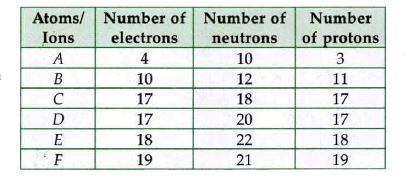Elements from A to F have in them the distribution of electrons, neutrons and protons as follows:

Making use of these data, find
a pair of ions
A pair of ions is A and B.
Because A has 4-3=1 negative charge and Bhas 11-10=1 positive charge.
Topper's Solved these Questions
- ATOMS, MOLECULES AND ATOMIC STRUCTUREBook:MTG IIT JEE FOUNDATIONChapter:ATOMS, MOLECULES AND ATOMIC STRUCTUREExercise:EXERCISE (Multiple Choice Questions)
Explore 50 Videos
- ATOMS, MOLECULES AND ATOMIC STRUCTUREBook:MTG IIT JEE FOUNDATIONChapter:ATOMS, MOLECULES AND ATOMIC STRUCTUREExercise:EXERCISE (Match the following)
Explore 6 Videos
- ATOMS, MOLECULES AND ATOMIC STRUCTUREBook:MTG IIT JEE FOUNDATIONChapter:ATOMS, MOLECULES AND ATOMIC STRUCTUREExercise:EXERCISE ( Integer/Numerical Value Type)
Explore 5 Videos
- COAL AND PETROLEUMBook:MTG IIT JEE FOUNDATIONChapter:COAL AND PETROLEUMExercise:OLYMPIAD/HOTS CORNER
Explore 10 Videos
Similar Questions
Elements from A to F have in them the distribution of electrons, neutrons and protons as follows:

Making use of these data, find
a pair of isobars
View SolutionElements from A to F have in them the distribution of electrons, neutrons and protons as follows:

Making use of these data, find
a pair of isotopes.
View Solution
Knowledge Check
The charge on the atom having 17 protons, 18 neutrons and 18 electrons is
A+1B−1C−2DZeroThe charge on the atom containing 17 protons, 18 neutrons and 18 electrons is.
A+1B−1C−2DZero
Elements from A to F have in them the distribution of electrons, neutrons and protons as follows:

Making use of these data, find
an atom of a noble gas
View SolutionState the number of protons electrons and neutrons in the following :
Ca
Ne
View SolutionFind the number of electrons , protons In
Sulphate ion
View SolutionFind the number of electrons , protons In
Fluoride ion
View SolutionThe table given shows the number of protons, neutrons and electrons in four ions. For which ion is the data correct?

View SolutionThe atoms of all the elements contains electrons, protons and neutrons. True/False explain.
View Solution
